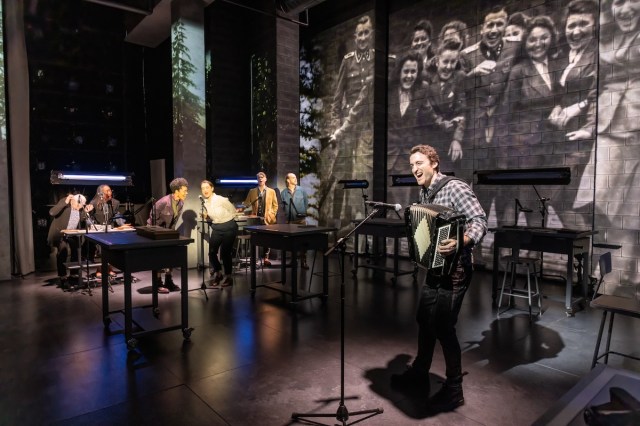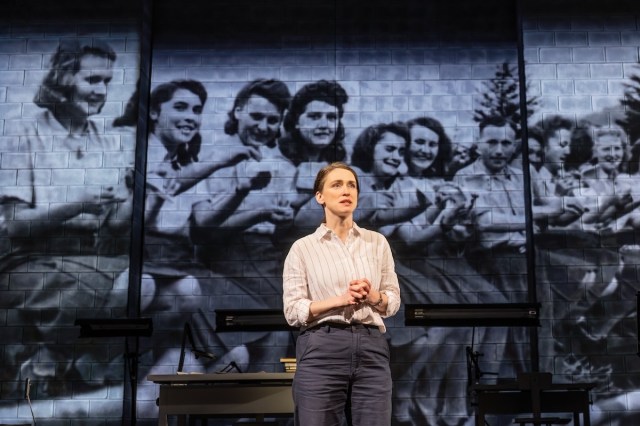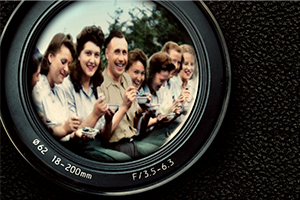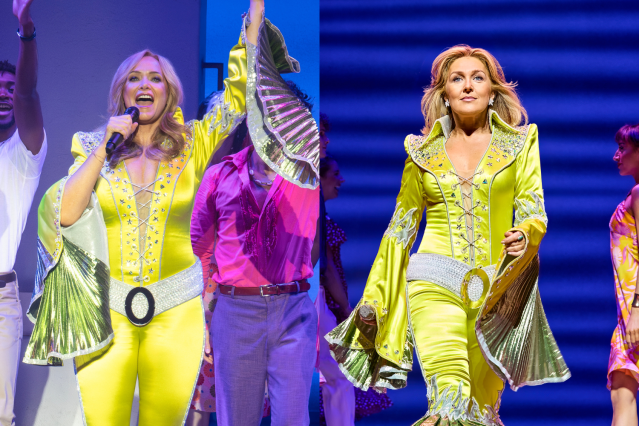Review: Here There Are Blueberries Depicts Nazis at Play in Auschwitz
Moisés Kaufman and Amanda Gronich’s Pulitzer finalist play opens at New York Theatre Workshop.

(© Matthew Murphy)
“We don’t want to elevate Nazis, to give them any kind of platform,” says the head of the United States Holocaust Memorial Museum as she and her archivists debate whether to exhibit a recently discovered photo album of SS officers enjoying their time at Auschwitz. She’s worried that the photos (which depict happy Nazis lounging by the Soła river, participating in sing-alongs, and munching on heaping bowls of blueberries) will humanize the perpetrators of the most shocking and industrialized genocide of the 20th century — that it will disrupt the narrative that they were monsters.
But Moisés Kaufman and Amanda Gronich make a compelling case that this narrative must be upended in their complex, thoughtful, and disturbing theatrical documentary Here There Are Blueberries, which is now making its off-Broadway debut at New York Theatre Workshop and which was just named a finalist for the 2024 Pulitzer Prize for Drama. The distinction is well-earned.
The play is co-produced with Kaufman’s Tectonic Theater Project, best known for the Matthew Shepard docudrama The Laramie Project. In the two-and-a-half decades since that landmark work, Kaufman has refined and perfected the company’s documentary theater style, resulting in a remarkably lucid presentation of a story that feels like a bad dream.
The album first comes to the attention of Rebecca Erbelding (Elizabeth Stahlmann), the youngest archivist at the museum. It was sent by an elderly army vet (Grant James Varjas) who claims to have discovered it in the basement of an apartment complex in Frankfurt. The archivists, led by Judy Cohen (Kathleen Chalfant), quickly identify this as the scrapbook of Karl Höcker (Scott Barrow), personal secretary to Richard Baer, commandant of Auschwitz.

(© Matthew Murphy)
The snaps depict high-ranking SS officers and, for the first time, offer photographic evidence of Dr. Josef Mengele at Auschwitz. After several of the photos are published in major newspapers, they capture the attention of a man in Germany named Tilman Taube (Jonathan Raviv), who recognizes his own grandfather as one of the doctors in the camp, which is news to him. These revelations push the archivists to reevaluate their knowledge of who was at the camp and what they knew — information that the people in the pictures actively sought to obscure after the war.
It’s true that history is written by the victors, but it is also buried by the losers, who, if they manage to survive, must inhabit a world ruled by their conquerors. We are repeatedly reminded that there are very few photos of Auschwitz before liberation. The largest collection was discovered by Lili Jacob, a former prisoner who found an album in a barrack after the Nazis fled before the advancing Red Army. Amazingly, the photos depict the day she and her entire family arrived from Hungary and constitute the only remaining images she has of them. Stahlmann steps into the role of Jacob to recount this story in what is undoubtedly the most emotionally gripping monologue of the whole play.
With gentle assertiveness, Raviv captures the noble curiosity of Taube, who not only wants history to record his grandfather’s role in the Holocaust, but seeks out the descendants of other Nazi officers to understand what, if anything, their families told them about that time. “My grandfather built the largest human killing center in all of history,” says Rainer (a skittish but never evasive Charlie Thurston), grandson of Rudolph Höss. Asking questions about grandpa was answered with a beating when he was a kid.

(© Matthew Murphy)
Special attention is given to the role of the Helferinnen, female auxiliaries who helped with clerical work and communications. These women were crucial in executing the logistics of mass murder, and none were ever prosecuted after the war — a tiny benefit (for them) of the prevailing narrative that it was only snarling male SS officers who were responsible for this atrocity.
The play benefits from Kaufman’s clear, almost prosecutorial staging, with each scene emerging from within the archivists’ workroom (stealthily versatile scenic design by Derek McLane). Dede Ayite costumes the actors in librarian chic, unimposing outfits that allow them to step in and out of character in a play in which everyone has several roles.
David Bengali’s projections are the star attraction, showcasing archival footage and the Höcker photos (some of which have been stunningly colorized) to give us a palpable sense of time and place. He has collaborated closely with lighting designer David Lander so that our attention is perfectly balanced between the screen and the stage (a very hard thing to pull off). Through live accordion music and the amplified sound of Teutonic laughter (sound design by Bobby McElver), the performers re-create and animate one of the photos, turning them into a three-dimensional and highly theatrical experience.
Here There Are Blueberries rolls out with the deft showmanship of a particularly good mystery novel, keeping us riveted until the very end. Most importantly, it forcefully asserts that it wasn’t just psychopaths who perpetrated the Holocaust: It was unassuming bank clerks, garden-variety careerists, and the smartest girls in class.










